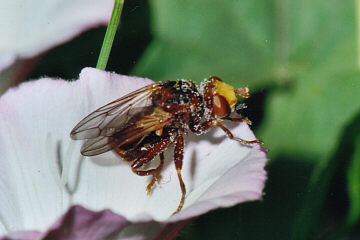
Introduction
Sicus are brownish flies that dwell in herb vegetations, often as fringes of forest or roads. It prefers parts with a lot of Cirsium arvensis. Females are spotted while jumping from leaf to leaf, using their wings only for a short while. Males are willing to mate with every other Sicus, resulting in towers of males on a single female. Thair larvae are endoparasites of bumble bees and have been found in Bombus terrestris, B. pascuorum, B. hortorum and B. lapidarius.
1.b. Tarsae black, trochanters and coxae partly darkened. Female: theca a little lower than broad at basis, projecting as far as hooked tip of abdomen, rounded and triangular in shape with bristle field facing backwards. Southern Europe and Russia, in western Europe up to Southern Germany -> Sicus nigritarsis Zimina
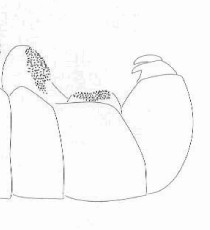
Theca of S. nigritarsis upside down (Stuke, 2002)
2.a. Theca not projecting ventrally, in side view 2-3 times broader than high. 8-10 mm. Common in the palaearctic. -> Sicus ferrugineus Linnaeus
2.b. Theca projecting, in side view almost as high as broad or higher than broad -> 3
3.a. Theca: bristle field facing backwards and for S. abdominalis also downwards, theca rectangular or triangular in shape, about as long or longer than hooked tip of abdomen; head: palpi shorter (mvv: shorter is not a good characteristic, but all Stuke (2002) gives) -> 4
3.b. Theca: bristle field facing downwards only, rectangular in shape, about half the length of the hooked tip of the abdomen; head: palpi long and dark. Alps only. -> Sicus alpinus Stuke
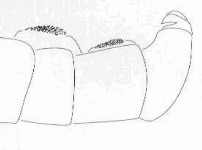
Theca of S. ferrugineus upside down (Stuke, 2002)
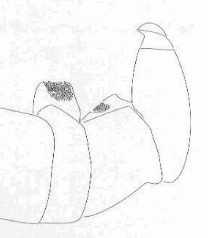
Theca of S. alpinus upside down (Stuke, 2002)
4.a. Theca in side view projecting further than hooked tip of abdomen, triangular in shape with its maximum width at the base; bristle field on theca facing backwards only. Palaearctic. -> Sicus fusenensis Ouchi
4.b. Theca in side view projecting at most as far as the tip of the hooked abdomen, rectangular in shape, with its maximum width in the middle; bristle field on theca facing backwards and downwards. Palaearctic. -> Sicus abdominalis Kröber

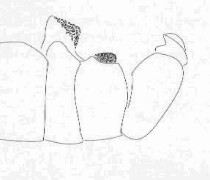
Theca of S. fusenensis, left, and S. abdominalis, right, both upside down (Stuke, 2002)
Stuke J.-H. 1996. Zum vorkommen der Gattung Sicus Scopoli, 1763 in Deutschland. entomofauna 17: 313-316.
Stuke J.-H. 2002. A new species of Sicus from Central Europe (Diptera: Conopidae). Mitteul. Schw. Entom. Gesel. Soc. Ent. Suisse 75: 245 - 252.
Van der Goot. 1977. Roof- en Blaaskopvliegentabel. Jeugdbondsuitgeverij, Utrecht.
Van Veen M. 1984. De Blaaskopvliegen en roofvliegen van Nederland en België. Jeugdbondsuitgeverij, Utrecht.